Relying on the trade machine at ESPN or Spotrac is probably the simplest way for NBA fans to verify whether or not a trade will work under league rules, but it’s a worthwhile exercise to examine and understand the primary tool in the NBA’s Collective Bargaining Agreement that determines a trade’s viability — the traded player exception.
Teams with the cap room necessary to make a trade work don’t need to abide by traded player exception rules. However, if a team makes a deal that will leave its total salary more than $250K above the salary cap, the club can use a traded player exception to ensure the trade is legal under CBA guidelines.
There are two different types of traded player exceptions used in NBA deals. One applies to simultaneous trades, while the other applies to non-simultaneous deals.
In a simultaneous trade, a team can send out one or more players and can acquire more salary than it gives up. In a non-simultaneous trade, only a single player can be dealt, and the team has a year to take back the equivalent of that player’s salary (plus $250K for non-tax apron teams).
Let’s look into each scenario in greater detail….
Simultaneous:
In a simultaneous trade, different rules apply to teams whose salaries are below the first tax apron and those whose salaries are above the apron. A non-apron team can trade one or more players and take back….
- 200% of the outgoing salary (plus $250K), for any amount up to $7,500,000.
- The outgoing salary plus $7.5MM, for any amount between $7,500,001 and $29,000,000.
- 125% of the outgoing salary (plus $250K), for any amount above $29,000,000.
Here’s a recent example of these rules in effect:
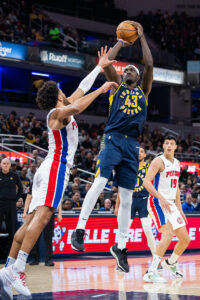 In January, the Pacers traded Bruce Brown, Kira Lewis, and Jordan Nwora to the Raptors in exchange for Pascal Siakam.
In January, the Pacers traded Bruce Brown, Kira Lewis, and Jordan Nwora to the Raptors in exchange for Pascal Siakam.
Brown was earning $22,000,000 in 2023/24, so if Indiana had traded him on his own, the team could have taken back $29,500,000 (his salary, plus $7.5MM). However, that wouldn’t have been enough to cover Siakam’s salary of $37,893,408.
By adding Lewis ($5,722,116) and Nwora ($3,000,000) to their trade package, the Pacers sent out a total of $30,722,116. The third rule listed above applies to that figure, meaning Indiana was able to take back 125% of the outgoing amount (plus $250K), for $38,652,645 in total — that was enough to cover Siakam’s salary, making the trade legal.
For apron teams, the traded player exception rules for a simultaneous trade are simpler, but far more restrictive. A team whose salary is over either tax apron can take back no more than 100% of the outgoing salary, no matter how much – or how little – outgoing salary is involved.
That means that if the Suns, who project to be a second-apron team in 2024/25, want to trade Nassir Little, they’ll be ineligible to take back a player earning even one dollar more than his $6,750,000 salary for next season.
A team’s position relative to the apron at the conclusion of the transaction dictates which set of rules they have to be abide by. For instance, a team whose salary sits just $2MM below the first tax apron can’t trade a $5MM player for a $10MM player, since that deal would push its salary above the apron. However, a team whose salary is $10MM below the apron could make that move.
In simultaneous transactions, the traded player exception is used to instantly complete the deal, leaving no lingering loose ends. This form of the traded player exception isn’t what we’re talking about if we say a team “has a trade exception” available to use. Those outstanding trade exceptions come as a result of non-simultaneous deals.
Non-simultaneous:
In non-simultaneous deals, a team can trade away a single player without immediately taking salary back in return. The team then has up to one year in which it can acquire one or more players whose combined salaries amount to no more than the traded player’s salary (plus $250K for non-apron teams).
For instance, when the Nets sent Joe Harris to the Pistons along with a pair of second-round picks last offseason, they didn’t take any salary back. That was a non-simultaneous trade from Brooklyn’s perspective, allowing the team to create a traded player exception worth Harris’ salary ($19,928,571).
The Nets subsequently had a year to use that exception to acquire one or more players whose salaries total up to $20,178,571 (Harris’ salary, plus $250K). They used a portion of it to acquire Thaddeus Young and his $8MM salary in a deal with the Raptors, leaving approximately $12MM left over. Trade exceptions expire after a year if they haven’t been used in full — the remainder of that one will expire on July 8.
A team can acquire one or more players as part of a non-simultaneous trade. For example, when the Knicks completed their OG Anunoby trade with the Raptors in December, they sent out RJ Barrett and his $23,883,929 salary, creating a non-simultaneous trade exception worth that amount and immediately taking Anunoby’s $18,642,857 salary into it. That reduced the value of the trade exception to $5,241,072.
A team can create a non-simultaneous trade exception regardless of whether its salary is under or over the tax aprons. If the Suns were to trade the aforementioned Little this offseason for a player earning $3.75MM, they would create a non-simultaneous trade exception worth $3MM and would have one year to use it.
Putting the two together:
When evaluating an NBA trade, it’s worth remembering that two teams can view the deal entirely differently and that they’re allowed to divide a single trade into multiple parts to maximize their flexibility. For example, one team could consider a trade simultaneous, while the other team breaks the transaction down into two separate trades, one simultaneous and one non-simultaneous.
Let’s take a look at a recent real-life example, examining the Anunoby trade mentioned above between the Knicks and Raptors.
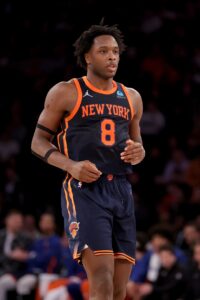 From the Knicks’ perspective, the trade broke down as follows:
From the Knicks’ perspective, the trade broke down as follows:
- Traded Immanuel Quickley ($4,171,548) for Precious Achiuwa ($4,379,527) and Malachi Flynn ($3,873,025).
- This trade is a simultaneous one for the Knicks, who were operating below both aprons, allowing them to take back up to 200% of Quickley’s salary, plus $250K. That figure works out to $8,593,096; Achiuwa and Flynn were earning a combined $8,252,552, making them a fit.
- Traded RJ Barrett ($23,883,929) for OG Anunoby ($18,642,857).
- This is a non-simultaneous trade, with the Knicks essentially creating a $23.88MM trade exception for Barrett’s outgoing salary and immediately taking Anunoby into it. As noted above, New York has until December 30, 2024 to use the remaining $5,241,072 on the exception.
Here’s how it looked from the Raptors’ perspective:
- Traded OG Anunoby ($18,642,857) for RJ Barrett ($23,883,929).
- In a simultaneous trade of Anunoby, the Raptors (also a non-apron team) were permitted to take back $26,142,857, which is the full amount of his salary, plus $7.5MM. That’s enough to cover Barrett’s $23.88MM salary, but not enough to take on Quickley too, since he was earning more than the $2,258,928 gap between Barrett’s salary and the amount Toronto could take back for Anunoby.
- Traded Malachi Flynn ($3,873,025) for Immanuel Quickley ($4,171,548).
- Because they couldn’t use Anunoby to acquire both Barrett and Quickley, the Raptors had to use Flynn’s outgoing salary in a simultaneous trade to take on Quickley. Toronto could have taken back up to $7,996,050 in salary for Flynn (200% of his salary, plus $250K), so Quickley is an easy fit.
- Traded Precious Achiuwa ($4,379,527) for “nothing.”
- Because Achiuwa’s salary wasn’t required for matching purposes, the Raptors moved him to the Knicks in a non-simultaneous trade, from their perspective, generating a trade exception worth his salary that they have until December 30, 2024 to use. They later used a $3MM chunk of that exception in a trade with the Pacers to take on Jordan Nwora. It’s worth noting that either Flynn or Achiuwa could have matched Quickley’s incoming salary, but teams will always use the smaller salary for matching purposes in that scenario, creating the trade exception with the bigger salary.
When a team can’t use a traded player exception:
Under the league’s current Collective Bargaining Agreement, teams above the first or second tax apron face additional restrictions related to traded player exceptions, besides not being able to take back more salary than they send out.
A team is not permitted to use a (non-simultaneous) traded player exception created during the previous offseason or regular season if its team salary will be above the first tax apron upon the conclusion of the deal. Using a TPE created during the prior year will hard-cap the team at the first tax apron for the subsequent season.
For instance, the Rockets used a trade exception they created in last October’s Kevin Porter trade to acquire AJ Griffin from the Hawks on Thursday. That means Houston’s team salary will be hard-capped at the first apron for the 2024/25 league year. If the Rockets had been operating above the first apron, that deal wouldn’t have been permitted as constructed.
Apron teams are still allowed to use newly created trade exceptions. Circling back once more to the Suns/Little example outlined above, if Phoenix traded Little today for a player earning $3.75MM, the team would be able to use the $3MM TPE generated in that deal for the rest of the offseason or ’24/25 regular season.
But the Suns can’t currently use any of the three trade exceptions they generated in July and September of 2023. If Phoenix were to move below the first tax apron during the 2024/25 league year, those exceptions would become “unfrozen” (assuming they haven’t expired) and could be used.
Here are a couple additional restrictions that apron teams face related to trade exceptions:
- A team is not permitted to aggregate two or more player salaries for matching purposes if that team will be above the second tax apron upon the conclusion of the deal. We have many more details on salary aggregation in a separate glossary entry.
- A team is not permitted to take back salary using a signed-and-traded player as the outgoing matching piece if that team will be above the second tax apron upon the conclusion of the deal. If a team creates a (non-simultaneous) traded player exception by sending out a player via sign-and-trade, that exception can’t be used if the team will be above the second tax apron at the conclusion of the transaction.
More notes on traded player exceptions:
- A team’s outgoing salary for matching purposes is the guaranteed salary rather than the total salary. For example, a player with a $2MM partial guarantee on a $10MM salary would only count for $2MM for salary-matching purposes for the team trading him (the team acquiring him would still have to account for him as $10MM in incoming salary). Between the end of a team’s season and June 30, the outgoing salary for a traded player is the lesser of his full current-season salary and his guaranteed salary for the next season. We have more details on this rule in a separate glossary entry.
- Trade exceptions created in non-simultaneous trades can’t be combined with one another, with other exceptions, or with a player’s salary; they can’t be used to sign a free agent (except in a sign-and-trade); and they can’t be traded outright to another team. However, they can be used to claim a player off waivers.
- The salary in a sign-and-trade can sometimes be subject to base year compensation rules. In that case, the player’s outgoing salary for trade purposes is either his previous salary or 50% of his new salary, whichever is greater. For instance, when the Heat signed-and-traded Max Strus to the Cavaliers last summer, Strus’ incoming salary from Cleveland’s perspective was $14,487,684, but his outgoing salary from Miami’s perspective was just $7,243,842.
- Teams that are under the cap before a trade and go over the cap as a result of the trade can’t create a trade exception as a result of that deal.
- Players signed using the minimum salary exception can also be acquired using the minimum salary exception in a trade, so matching their salary using a traded player exception is not required. A tax apron team is permitted to acquire a player using the minimum salary exception without matching salaries.
- For salary-matching purposes, future draft picks or the draft rights to an unsigned player aren’t taken into consideration. Neither is cash, which can be sent out in a trade by teams below the second apron.
- Teams will be permitted to use the non-taxpayer mid-level, room, and bi-annual exceptions as de facto trade exceptions beginning in 2024/25. For instance, a club could trade for a player earning $10MM using the non-taxpayer mid-level exception.
The traded player exception is one of the CBA’s more complicated tools and can make it challenging for over-the-cap teams to navigate the trade market. It’s undoubtedly simpler to use an online trade machine to determine whether a deal is legal, but examining the rules and figuring out exactly how a blockbuster trade breaks down can provide rewarding insight into an NBA club’s management of its cap.
Note: This is a Hoops Rumors Glossary entry. Our glossary posts will explain specific rules relating to trades, free agency, or other aspects of the NBA’s Collective Bargaining Agreement. Larry Coon’s Salary Cap FAQ was used in the creation of this post.
Earlier versions of this post were published in previous years.
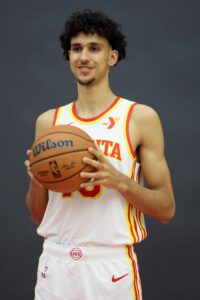 In every NBA league year, rookie scale amounts are assigned to each first-round slot, from No. 1 through No. 30. Teams can sign their first-rounders to as little as 80% of that rookie scale amount, or up to 120% of that figure.
In every NBA league year, rookie scale amounts are assigned to each first-round slot, from No. 1 through No. 30. Teams can sign their first-rounders to as little as 80% of that rookie scale amount, or up to 120% of that figure.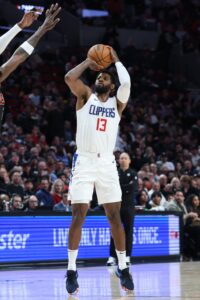 While we didn’t get quite as much action on day one as expected, there were still a good deal of notable headlines, including
While we didn’t get quite as much action on day one as expected, there were still a good deal of notable headlines, including 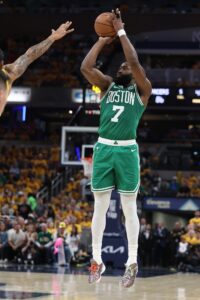 The first chart shows the maximum salaries for a player re-signing with his own team — a player’s previous team can offer five years instead of four, and 8% annual raises instead of 5% raises. The second chart shows the maximum salaries for a player signing with a new team.
The first chart shows the maximum salaries for a player re-signing with his own team — a player’s previous team can offer five years instead of four, and 8% annual raises instead of 5% raises. The second chart shows the maximum salaries for a player signing with a new team.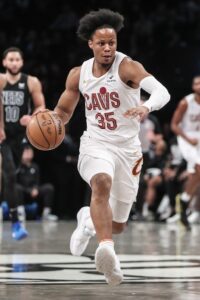
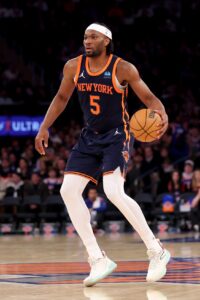
 In January, the Pacers
In January, the Pacers  From the Knicks’ perspective, the trade broke down as follows:
From the Knicks’ perspective, the trade broke down as follows: